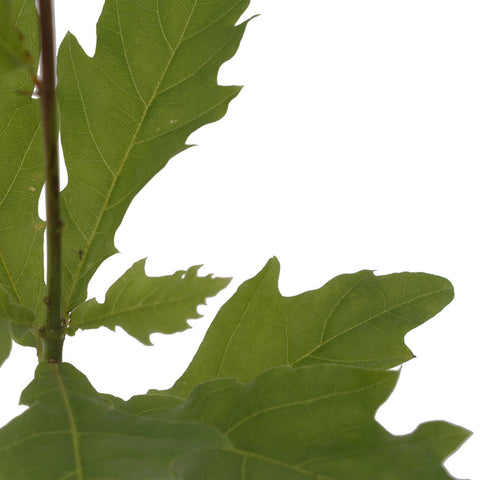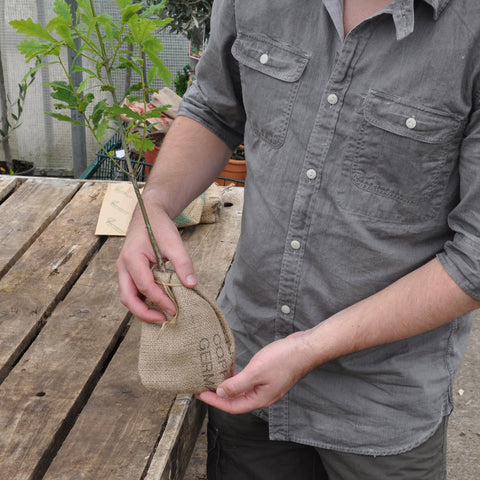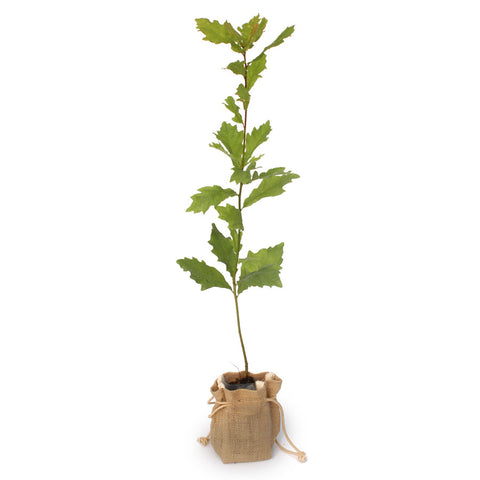Common Oak Tree Facts and Information
Oak Trees Facts and Information
Quick Oak Tree Facts
- Latin name: Quercus robur
- Native words: Old Irish (duir) Scots Gaelic (darach) Old English (ac) Welsh (derwen) eastern Celtic (derva)
- Ogham sign: D
- Height when mature: 30 - 40m 100 ft
- Height after 10 years:

Oak Tree Botanical Description:
Types of Oak
There are 2 native British oak tree species;
- Common, or Pedunculate oak (Quercus robur)
- Sessile Oak (Quercus petraea)
Sessile oak was the first to arrive in the British Isles, and grows naturally in upland areas; Quercus robur prefers lower regions.
Oak tree identification
There are 2 key distinguishing features between sessile and pedunculate oak. The first is the acorn. On pedunculate oak they are borne on stalks (or ‘peduncles’), sessile acorns are not. Secondly, in winter if you look at the dead leaves remaining on the tree, you will see that the leaf stalks on pedunculate oak are very short.
In late winter and spring, light brown buds which look like small nuts are arranged spirally around outer twigs and are clustered at the twig tips. The leaves emerge between mid-April and Mid May.
Oak Leaves
Oak leaves are quite distinctive, having 3-6 unequal ‘thumb’ shaped lobes on either side of the leaf, which gives it a wavy edged look. Often tiny discs appear on the underside which are made by insects and called galls but do not seriously affect the tree. Leaf fall occurs in October and November.
Oak Flowers
Oak trees do flower, with the male flowers appearing as slender pale green catkins and the female flowers on spiked stalks behind them. The male catkins appear with the first leaves.
Oak Fruits
The green acorns develop during the summer and sit in a small cup. Oaks do not necessarily produce acorns every year. When they do, the acorns fall usually leaving the cup behind and turn brown as they lie on the ground. Once they have fallen, an acorns first task is to send out a red shoot which roots in the ground and becomes the main taproot. This descends deeply seeking out water.
Oak Life Cycle
Next spring a main shoot appears and two opposed leaves, recognisably oak, develop left to their own devices, mature Oaks can have a massive spread to them and are often as wide as they are tall, which increase the sense of grandeur when one regards them.
Outer branches regularly die and fall, leaving decaying or dead stumps which are a common feature of the tree.
After a while, the oak starts to undergo a process known as ‘crown death’ which is a natural part of its life cycle. As the name suggests, the highest branches start to die back first. The heartwood of the main trunk will also die and rot without killing the tree, so that oaks often have the appearance of being three-quarters dead, and yet they are still healthy.

Oak Tree Natural History and Ancient Wisdom:
The Oak Tree can live up to 1000 years old but are generally mature at 75, and live on average 150-250 years. Today they are the commonest British native tree met within woods and hedgerows.
Their great utility for man has meant no other tree has played such an important role or been so valued by humans, even to the extent of being an object of worship and veneration.
Many of the most ancient oaks in the British Isles are pollarded trees. Oaks were pollarded for a variety of reasons. It was mainly undertaken to encourage the growth of large branches at the crown which could be used for building timber. Oak wood is so durable and strong it was prized for roof timbers in great medieval grain barns and churches, such as Lincoln Cathedral.
Green oak (that is unseasoned) was invaluable for shipbuilding. Great warships such as Henry VIII’s Mary Rose and Grace a Dieu were built almost entirely out of oak, as were nearly all ships before the construction of the iron ‘Great Britain’; 2000 mature oak trees were used to build one ship in 1812. Whole forests of pollarded oak were reserved for naval shipyards and some still survive.
Oaks other great asset was its seed, better known as acorns. From ancient times and throughout the medieval period, pigs were moved into pasture woodland to feed on acorns in autumn. In the Domesday Book many woods were calculated in value according to the number of swine they would support, which indicates oak was the commonest tree. The right to graze pigs known as “pannage” was often keenly disputed and jealously guarded. It meant that large oak forests were maintained because of their acorn crop. So valuable and significant to communities was this function that it entered mythology of early societies: In Irish myth, Fer Caille (“Man of the Wood”) is a semi-divine figure who appears as a swineherd with one eye who carries a black pig. He is clearly derived from a woodland deity. The sinister gargoyle still to be seen in the roof or pillars of many English churches surrounded by oak leaves known as Jack in the Green or the Green Man has a similar ancestry. Oak leaves around the Green Man in churches reflected the survival of a strong association between oak and sacred spaces from pagan belief into Christianity.
The sacred oak of Ireland was at Dunmanogoe while the earliest Christian synod in England met at St Augustine’s oak in Herefordshire. The Kings of Tara in Ireland met under Oaks. Ironically, this role of oaks as sacred meeting places was transferred from pagan religions. The presence of sacred oak groves where Celtic people worshipped was well known in classical times and commented on by writers such as Strabo and Pliny. The survival of giant oaks which had lasted generations probably lies behind why certain trees became sacred. This was a tree which probably started as a recognisable way marker in the forest and a communal meeting place because they were so massive and old, and became well known over time, respected for their longevity and role in pannage existing as part of the community.
As they became associated with sites of power such as moots, religious authorities would have sought to access the power space oaks represented. Others who wanted to break that power recognised the potential of oaks. The Romans undertook a wholesale felling of sacred groves upon their conquest of England; from now on people would not look to the oak as gathering places or places where power was held and distributed. But the survival of oak as the symbol of strength and landscape heritage (the National Trusts symbol is oak leaf and acorns!) shows they did not succeed!
Oak Tree Place Names:
There are thousands of place names derived from oak. This is a testimony to the intimate relationship between this tree and the peoples of the British Isles.
As well as village names there are many individual farm and field names of ancient heritage reflecting an association with oak trees. Look at an Ordnance Survey map and find the Broad Oak or Great Oak farms and lanes that point to where ancient trees grew (and sometimes still do!).

Anywhere that begins with ‘Ac’:
- Acton Bridge (Cheshire) - ‘settlement by a bridge where oaks grew’
- Acle (Norfolk) - ‘oak wood’
- Acrise (Kent) - ‘oak copse’
- Accrington (Lancashire) - ‘settlement where acorns are found’
- Aqualate Mere (Staffordshire) - ‘oak glade mere’
- Oakenshaw (West Yorkshire) - ‘Oak wood’
- Oakleigh (Kent) - ‘in the lee of the oak wood’
- Hatfield Broad Oak (Essex) - ‘heath where the big oak grew’
- Copdock (Suffolk) - ‘coppiced oak’ or ‘oak rising to a summit’
In Ireland ‘derry’ means an oak wood. Kildare means “Church of the Oak”. The old Celtic word ‘derva’ appears in the place name derwent as in the river Derwent and Derwentwater (Cumbria). It means river or lake by which oaks grow.
Oak Tree Wildlife Rating:
Excellent.
284 insect species have been found living in oaks. The Purple Hairstreak and Purple Emperor butterflies rely on oak.
Jays and Squirrels, which both feed on them, spread the acorn by carrying them away and burying them in the ground.
Most British bats roost in the crevices and hollows, and Great Spotted Woodpeckers, Spotted Flycatchers, Nuthatches and Treecreepers find food and nest holes on oaks.
Wild Primroses, Bluebells and wild garlic and wild violets all rely on the rich soil beneath oaks to thrive. Some ecologists argue individual oaks should be designated nature reserves in their own right!
Common Oak Tree Good Points:
- Ideal for large gardens and landscapes and are excellent for filling gaps in hedgerows or native woodland, as they survive well.
- Many woodland and shade loving plants such as wood anemones and aconites will do well under oaks.
Common Oak Tree Bad Points:
- Oak trees require substantial amounts of water and will send out extensive, deep roots in search of it.
- Mature oak trees will draw up large quantities from a garden, rapidly removing water and nutrients from other plants.
- A new disease of oaks known as “Sudden oak death” or Phytophthora ramorum has struck native oaks in recent years. P. ramorum invades plants through the bark and cuts off the flow of food from the leaves to the roots. Eventually, the roots die, causing the upper tree and limbs to die from lack of water. The trees must be felled.
Order an Oak Tree
If you're looking to buy an oak tree then we might be able to help. We have been offering our award winning gift services for over 15 years and specialise in sending trees as gifts all over the UK, Ireland and Europe.
Oak trees are long-lived and shrouded in history and mythology making them extremely meaningful when sending them as gifts. Our Oak Tree Gift is very popular can be added to a variety of tree gift packs for memorials, weddings and anniversaries as an extra special gift that will never be forgotten.
Commonly called the "Father" or "King of the Woods" the oak tree stands proud and tall with an imposing stature and strong roots. If you are interested in a more established tree the English Oak Tree Gift is delivered in a 7L pot and is approx 1.5m tall.
We also offer something a little more unique when it comes to oak trees. Ever heard of a Truffle Tree? We have a very special Oak Truffle Tree Gift that has roots inoculated with unique truffle spores that after around 5 years will start producing delicious truffles that can be harvested and used in the kitchen.
If you're a corporate customer looking for eco-friendly gift incentives then you've come to the right place. We offer a fully bespoke gift service for promotional products and projects. Get in touch at corporate@tree2mydoor.com with your ideas and we can help bring your ideas to reality.